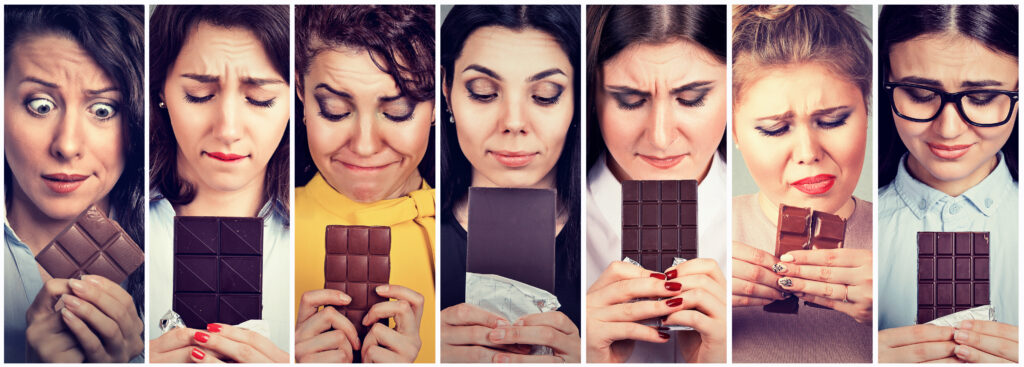
Crush your food cravings
We all experience food cravings and it may not even be your fault!
Food companies hire food scientists to engineer and create tastes and textures in foods that are difficult to resist.
Salt, Sugar, and Fat…
It’s their job to find the perfect formula that makes you crave more!
They know there are certain substances that we will want more of.
There’s a science to it!
When food, or food-like substances, are DESIGNED PURPOSELY to make them crave-able, we need to remember that it’s in the best interest of the food industry to create food that would have us overeat…right?
So, you’re not alone if this something that you struggle with too!
We’re going to look at NINE ways to deal with your CRAVINGS!
Some of these might surprise you!
Cravings can be triggered by many things including – the 4 “S’s”:
- Sights
- Sounds
- Smells
- Surroundings
- Stress, and more.
Our appetite and eating habits do not exist in a bubble, cravings can be triggered by things that are part of our daily lives.
The better we understand our cravings, the better we can constructively deal with them.
It’s not realistic to think that you will NEVER eat sugar. But, in reality, most of us are consuming WAY too much added sugar.
We are inundated each day with food choices that are low in nutrients yet high in calories.
Packaged food, fast food, and junk foods are convenient, but we’re paying the price with our health.
When we consume these highly processed, nutrient-void foods, our body knows it’s not getting what it needs, so it craves more – more NUTRIENTS!
But often, we are just giving our body more FOOD – empty calories, that are LACKING in the nutrients our body NEEDS!
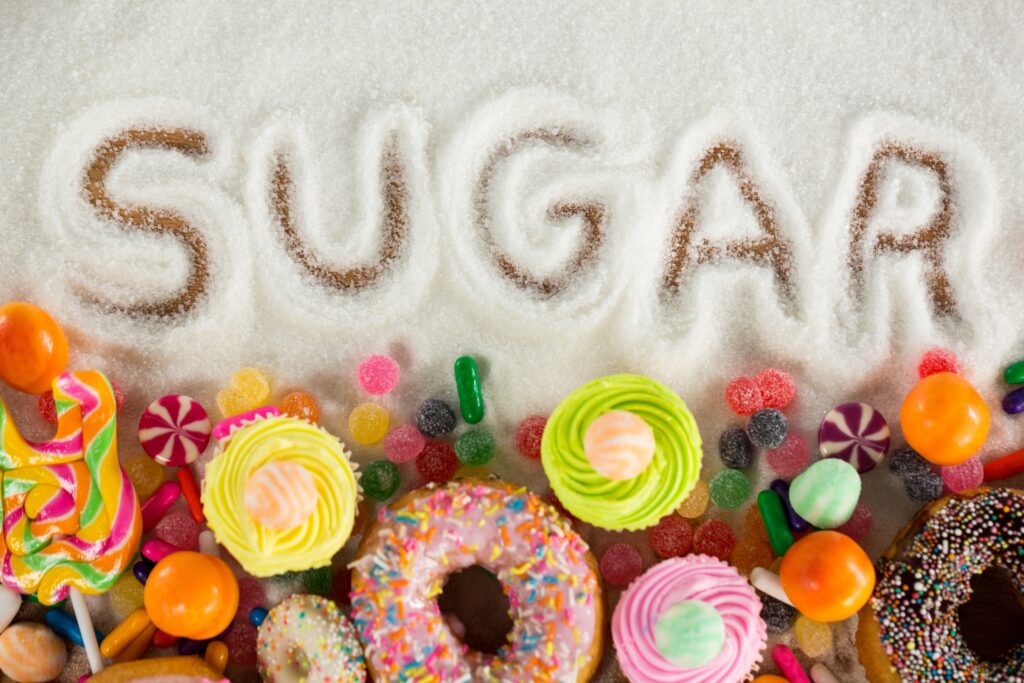
Sugar
According to Medical News Today, the average American consumes about 82 grams of sugar a day.
That’s more than 65 pounds of sugar per year.
Equal to nearly 20 teaspoons of sugar a day!
Some sources estimate that we consume even more!
The majority of sugar we take in is hidden in highly processed and fast foods, cereals, snacks, as well as white flour products.
Sugar is even in salad dressings, sauces, and beverages.
Products that are often labeled “healthy,” for marketing purposes, can be loaded with added sugars.
Sugar can makes us feel happy, more energetic, and it can even make us sometimes even make us feel calmer.
HERE’S WHY:
Sugar releases chemicals in our brain that make us feel good emotionally, but it’s only temporary.
Following the initial rush, comes the CRASH!
So, then what can we do to reduce our food cravings?
9 Ways To Reduce Food Cravings
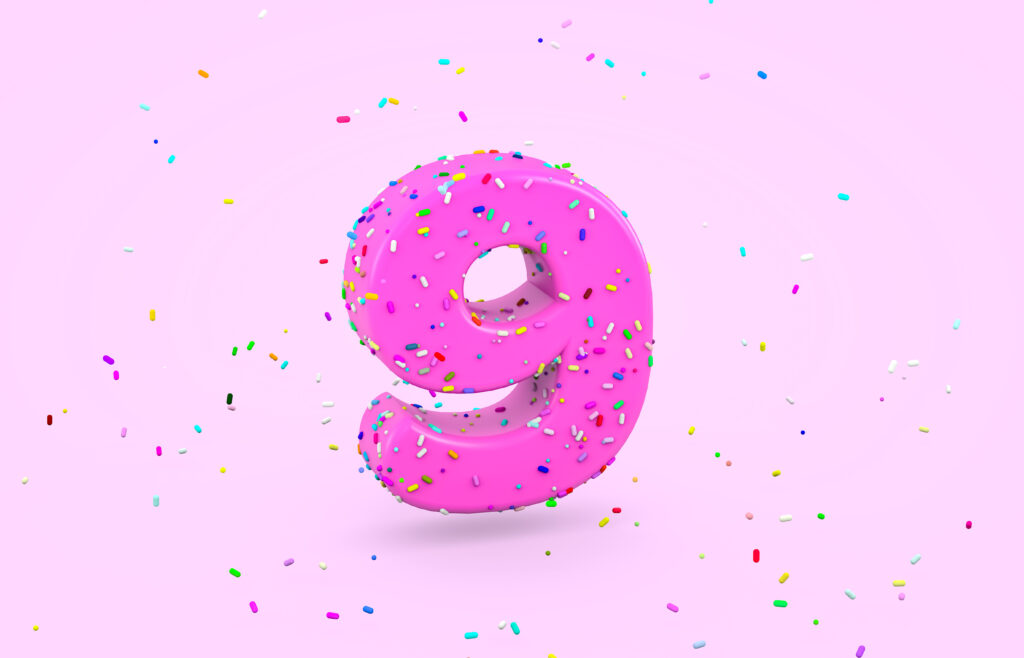
Let’s countdown the nine ways you can reduce your cravings for sugar or other unhealthy foods and drinks.
#1. Don't Skip Meals
When we skip meals, we may think we’re reducing our calories for the day.
But, by mid-afternoon, hunger will often hit with a vengeance!
So, we often give in to the temptation. Then, we get upset with ourselves for failing.
This can often lead to eating even MORE empty calories…
more sugar…more processed food…
Because we again feel like we’re are starving, and we’re stressed-out from failing.
We can avoid this chain of events by spreading meals out, as evenly as possible throughout the day.
Also, ensure that your meals are based on whole foods.
And, add a healthy snack when needed.
This will likely keep your blood sugar more stable.
#2. Don't Bring Temptation Home

This may sound overly simple. But, it’s oh so true!
If you want to make good choices, only keep healthy foods in the house.
It’s because it’s, engineered that way!
When you buy something from a fast food, restaurant or the snack food aisle, or even anything that comes in a bag or a box, a lot of money has been spent on research and development.
Food manufacturers employ researchers, chemists, and engineers.
They do this because they want to develop processed foods or food-like substances that taste amazing.
These experts know the precise combination of salt, sugar, and fat that will make something absolutely delicious and leave you wanting it again and again.
They even often add artificial flavorings such as MSG to make that salt, sugar, and fat taste even better.
And, after they’ve created these foods, they spend even more money marketing them to you.
They spend money on packaging and ads, and they even pay the grocery stores to put it in a prime location on the shelves, so that you’ll pick it up, put it in your cart, buy it, and take it home!
Sometimes these products can even appear to be healthy, but make no mistake if it comes from a bag or a box or a fast food restaurant, chances are that it’s not high in quality, and it’s lacking in nutrients.
Knowing that shelf placement is an advertisement should make you think twice before you pick something up, and if you leave it on the shelf, you can’t eat it, right?!
I like to keep my fruits and vegetables at eye level and right upfront.
This is the same strategy that grocery stores use to get you to buy items.
You’re much more likely to grab something when it’s within easy reach.

This will work with your kids too!
Plus, if you don’t have any junk food in the house, you can’t eat any, right?
So, stock your kitchen with whole foods that fill you up, satisfy your hunger, and give your body the nutrients it needs.
There are trillions of bacteria and hundreds of different kinds of them living in your gut.
The thing about this bacteria is that some of them are more helpful than others.
And, some of them have specific jobs that help keep you healthy, happy and energized.
All of those different types of bacteria feed on different kinds of food, some might like more fats.
Some like sugary foods, you get the idea…
But they get their food from the food that you eat.
And, research is demonstrating that those bacteria might actually be telling you what to eat!
Scientists at the University of California in San Francisco have found evidence of this.
They still don’t know exactly which bacteria craves, which kind of food, but they do say that what you eat can influence how much of a certain kind of bacteria you have in your body.
So, if you eat a lot of junk food, you will probably have more bacteria that crave junk food!
Which also means, if you eat less junk food, you probably have bacteria that crave less junk food!
Pretty cool, right?
So this leads me to one little word to help you stop craving it’s the word, NO!
Saying it for a few days when you feel cravings for certain foods can be a powerful way to take back control.
I know, it’s easier said than done, but just not bringing unhealthy food into your home can help!
After a few days, the gut bacteria that are driving these cravings might back off a bit and with it also other cravings,
3. Eat Enough Protein, Fiber, & Healthy Fat
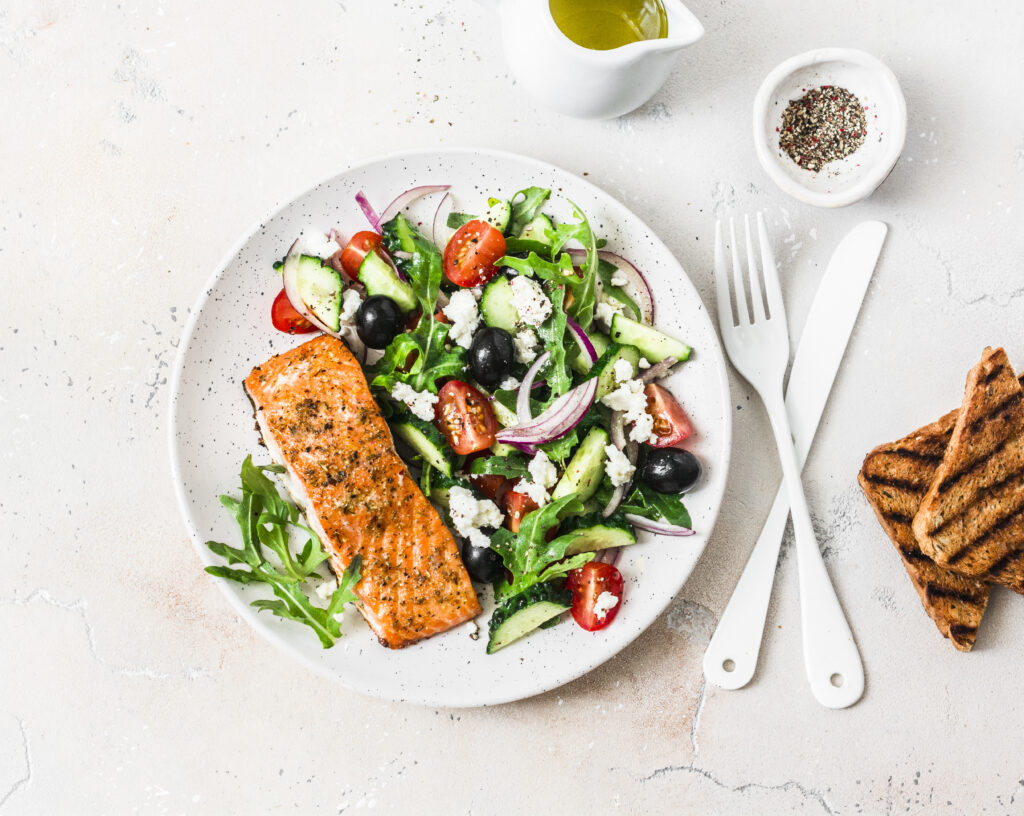
This matters because protein, fiber, and healthy fat will help keep your blood sugar levels in check, which is huge when it comes to preventing cravings.
Plus, protein keeps you feeling fuller longer than other nutrients
Remember the low-fat diet craze that caused all of us to fear any source of dietary fat?
I used to think that it was perfectly ok to eat an entire box of Snackwells cookies!
Remember those???
Well, when you take fat out of something, it tastes terrible!
So, the food companies added more SUGAR to make it palatable!
The truth is that our bodies desperately need healthy fats to function properly.
Excellent sources include fatty fish such as wild caught salmon, seeds, extra-virgin olive oil, and organic eggs.
So, don’t fear fats!
If you’re not getting enough, it may be time to add healthy fats to your diet.
This can go a long way to keeping those cravings in check!
Glycemic Index
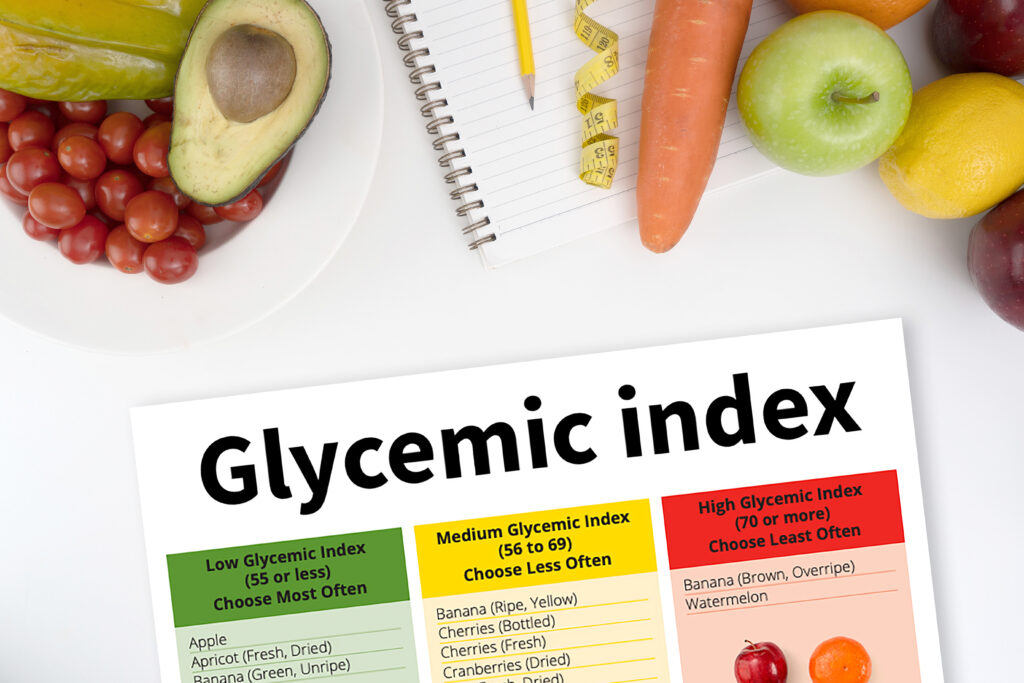
The foods that measure high on the Glycemic Index can set you up for cravings.
The Glycemic Index measures food on a scale from 1 to 100, depending on how fast it will raise your blood sugar levels.
The faster and higher the food makes your blood sugar go up, the higher its Glycemic Index number is.
This matters because when your blood sugar goes up, your body sends out hormones such as insulin to help remove it.
These hormones can cause a blood sugar “crash” that can make you feel tired or shaky a little after you eat it.
We’ve all been there!
Plus, it can also bring that “hangry” feeling. Which is a combination of hungry and anxious or angry, which makes you want to eat more and get your blood sugar level back up.
I’m sure you’ve experienced this!
This is a cycle that is difficult to break once your body gets used to it over time.
All those insulin surges become linked with insulin resistance, which means that your cells aren’t as receptive to insulin.
Insulin resistance is a significant precursor for type 2 diabetes and other health issues like heart disease.
The number of people with type 2 diabetes has increased by almost 300 percent since 1980, with more than 400 million people now having the disease.
This is a significant health issue, and pretty scary!
So, a good idea to eat foods that don’t cause big spikes in your blood sugar levels.
The Glycemic Index mostly applies to foods containing carbohydrates, but (like most things) it’s not that simple.
Your blood sugar doesn’t just respond to the number of carbohydrates or natural sugars in food.
The amount of fiber, fat, and protein in food also plays a role in slowing down the blood sugar response.
For example, corn flakes cereal has a glycemic index 81.
While an apple has a glycemic index of only 36.
The cereal is a processed food that’s basically a sugar delivery system.
It has very little fiber in it to slow down the impact on your blood sugar.
While the apple contains natural sugar, it also contains fiber that helps slow down how quickly it makes your blood sugar level rise. Fiber also helps to keep you feeling full.
Besides having health benefits, it also means that the apple can help you to avoid cravings later in the day.
There are a few things you need to know about the scale, though.
The Glycemic Index measures each food as if you were eating it on an empty stomach, and most of us don’t do that when we eat!
Instead, we eat a few different foods at the same time.
For example, suppose you were to eat white rice, which has a Glycemic Index of 87.
In that case, chances are you’d, be eating it with something else, like beef and broccoli – which have a GI index of 0 and 10, respectively.
The second issue is that your food is so much more than its impact on your blood sugar.
It also contains vitamins, minerals, and compounds your body needs.
For example, peanut M&Ms are highly processed but have a relatively low glycemic index of only 33.
Macaroni and cheese has an index of 64.
And, baked potatoes, which are all-natural and packed with vitamins and minerals, come in on the GI scale at 85.
Also, portion sizes still matter, and definitely count if you’re trying to maintain or lose weight.
So, consider the overall glycemic load of your meal.
By that, if you’re eating a food that you know has a high glycemic index – something high in carbs – balance it out by eating something with protein or healthy fat like the rice, beef, and broccoli, for example.
Or, if you’re eating a high glycemic food like grapes, which have a GI of 60, you can add some healthy fats, such as a handful of nuts, which will slow down the sugar surge.
In fact, this is where the old-fashioned square meal comes into play way before the glycemic index was ever invented.
Our grandparents and great grandparents naturally balanced out the meals they served with a protein, starchy carbohydrates, and vegetables.
4. Get a Good Night's Sleep

Are you sure you’re getting enough sleep each night?
And, do you get quality sleep?
Consider how your entire day goes when you wake up tired, as opposed to the way you feel and how your day goes after a good night’s sleep!
Feeling tired, stressed, or exhausted will trigger food binges.
Plus, when we’re tired, we get stressed more easily!
Research, published in the American Journal of Human Biology, demonstrated that short or poor-quality sleep is associated with obesity by de-regulating appetite and increased energy consumption.
5. Be a Food Label Detective
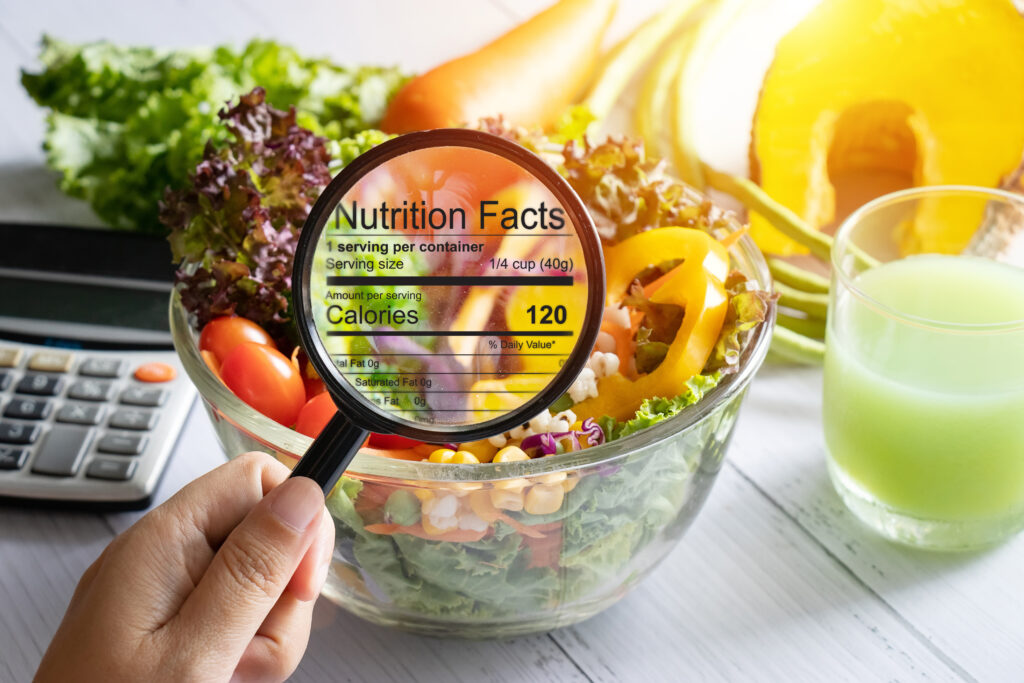
We’ve been told to look at the calories and fat content on labels, but what about actual INGREDIENTS?
It can be nothing short of shocking when we become aware of what our food is made up of these days.
To eat healthy, you NEED to know what’s in your food!
So, you must read the ingredients label!
Sugar can often disguised with different names as well as listed more than once under these different names.

These are just a few of the names sugar can go by: high-fructose corn syrup, raw sugar, brown sugar, beet sugar, cane sugar, sucrose, dextrose, maltose.
Additionally, if there are a lot of ingredients listed that you don’t recognize or can’t pronounce find another option.
6. Eat Something Healthy, First

Don’t tell yourself you can’t have something that you’re craving!
Instead, eat something nutritious, such as a banana and a few nuts or a fresh salad with some protein – before you give into the craving.
Often, when you’re finished with the healthier choice, you are way less likely be craving the sugar anymore and will likely just skip it.
7. Satisfy Sugar Cravings with Healthy Sweets

Did you know that approximately 40% of what we do every day is purely the result of habit?
What this means is that sometimes we reach for a sugary snack just out of habit.
Do you reach for a bagel or donut, after you pour yourself a cup of coffee?
Healthy sweets are packed with vitamins, minerals, and antioxidants that can actually HELP us become healthier and feel better.
#8. Stay Hydrated
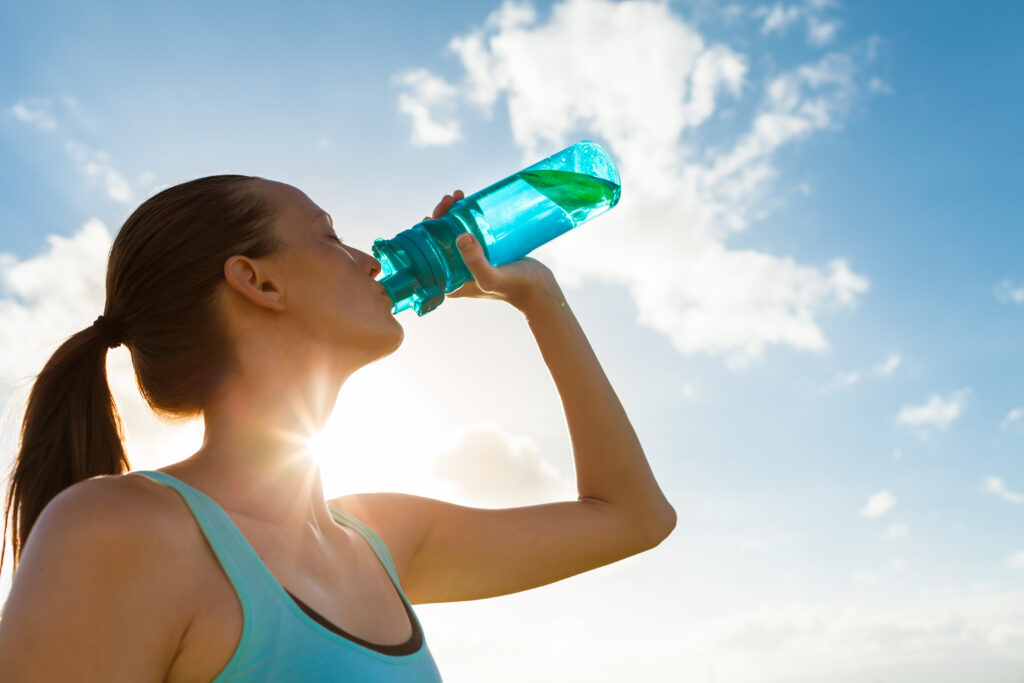
Sometimes we confuse thirst for hunger!
Dehydration can lead to food cravings.
Most people don’t drink enough water.
So, try this the next time you have a craving: Drink a full glass of water. Then, wait 10 minutes. Do you still have the craving?
9. Are you actually hungry?
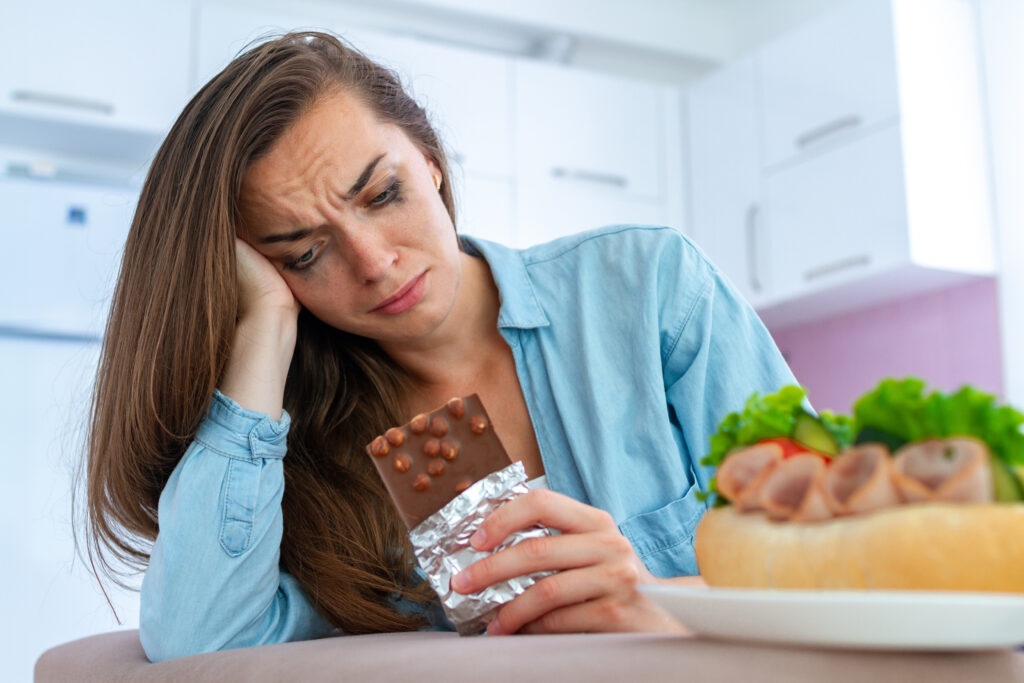
Sometimes cravings can be caused by things we feel are missing from our lives and food can fills a void for us.
We may be conscious of this, or not. Stress, feeling bored, or even being lonely can do this as well.
Ask yourself if you’re REALLY hungry for food…or is it something else?
If you just ate an hour ago and felt full, maybe you are not even hungry!
What do you crave that’s not food?
Ways to Reduce Cravings from Boredom or Emotions
What are some things you can do beside focusing on food?
Make your own list. Here are some ideas to get you started:
- Exercise: Take a walk, stream a workout, do yoga – you do you!
- Enjoy a hot shower or relaxing bath
- Catch up with a friend
- Learn something new
- Put together a puzzle
- Spend time doing something that means something to you.
Try different things to find out what works best for you, and focus on doing things that YOU enjoy.
Sometimes we will crave food when we’re bored because eating just provides us with something to do.
So, remember to check in with yourself to determine if you’re actually hungry.
Conclusion

When you have an understanding of the connection between WHAT you eat, WHY you eat, and HOW you feel, you become more in control and better able to make good food choices.
So, try to determine if your food cravings are based on habit or what you are keeping in the house and consider how to best address those issues to make real changes.
You don’t need to feel guilt when it comes to food.
We all just need to understand our food cravings better, so that we can figure out what we actually need and then do our best to make choices that support our health goals.
If you are looking for a boost to assist you with your health, fitness, and weight loss goals, be sure to check out my programs!
Click here to view the programs.
There are options to suit every budget and all the programs are designed to help you achieve your goals successfully!

